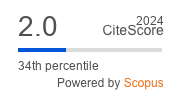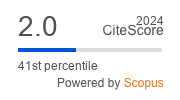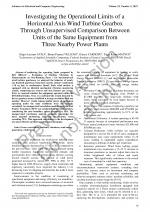| 2/2025 - 3 |
| Extra paper information in |
| Click to see author's profile in |
| Download PDF |
Author keywords
correlation, turbines, vibrations, wind energy generation, wind farms
References keywords
wind(32), turbine(14), review(12), energy(12), turbines(11), access(10), vibration(8), renewable(7), data(7), maintenance(5)
Blue keywords are present in both the references section and the paper title.
About this article
Date of Publication: 2025-06-30
Volume 25, Issue 2, Year 2025, On page(s): 19 - 26
ISSN: 1582-7445, e-ISSN: 1844-7600
Digital Object Identifier: 10.4316/AECE.2025.02003
Abstract
Considering the operating limits proposed by ISO 10816-21 Evaluation of Machine Vibration by Measurements on Non-Rotating Parts for horizontal-axis wind turbine gearboxes, we analyzed the behavior of nearly one hundred gearboxes from three nearby onshore wind farms (~10 sq km) in northeastern Brazil. Each wind turbine is equipped with an identical mechanical vibration monitoring system, comprising ten sensors and nine features per sensor. First, we assessed whether the equipment operated within the ISO-defined limits. Next, we confirmed the trends detected by the ten gearbox sensors exhibited a strong correlation with one another. However, trends among similar pieces of equipment operating under the same conditions were not strongly correlated. An unsupervised correlation analysis using the Fast Fourier Transform (FFT) was conducted for all wind turbines, considering the zone boundary values proposed by ISO. The unsupervised correlation analysis enhances knowledge for more targeted monitoring, achieving an accuracy score exceeding 70%. This approach contributes to the development of a more effective predictive maintenance program. |
| References | | | Cited By |
Information from Web of Science® will be displayed on the next page reload.
We were unable to retrieve information about this paper in SCOPUS®.
Message: [Returned results: 0]
There are no citing papers in the CrossRef Cited-by Linking system.
Disclaimer: All information displayed above was retrieved by using remote connections to respective databases. For the best user experience, we update all data by using background processes, and use caches in order to reduce the load on the servers we retrieve the information from. As we have no control on the availability of the database servers and sometimes the Internet connectivity may be affected, we do not guarantee the information is correct or complete. For the most accurate data, please always consult the database sites directly. Some external links require authentication or an institutional subscription.
Web of Science® is a registered trademark of Clarivate Analytics, Scopus® is a registered trademark of Elsevier B.V., other product names, company names, brand names, trademarks and logos are the property of their respective owners.
Faculty of Electrical Engineering and Computer Science
Stefan cel Mare University of Suceava, Romania
All rights reserved: Advances in Electrical and Computer Engineering is a registered trademark of the Stefan cel Mare University of Suceava. No part of this publication may be reproduced, stored in a retrieval system, photocopied, recorded or archived, without the written permission from the Editor. When authors submit their papers for publication, they agree that the copyright for their article be transferred to the Faculty of Electrical Engineering and Computer Science, Stefan cel Mare University of Suceava, Romania, if and only if the articles are accepted for publication. The copyright covers the exclusive rights to reproduce and distribute the article, including reprints and translations.
Permission for other use: The copyright owner's consent does not extend to copying for general distribution, for promotion, for creating new works, or for resale. Specific written permission must be obtained from the Editor for such copying. Direct linking to files hosted on this website is strictly prohibited.
Disclaimer: Whilst every effort is made by the publishers and editorial board to see that no inaccurate or misleading data, opinions or statements appear in this journal, they wish to make it clear that all information and opinions formulated in the articles, as well as linguistic accuracy, are the sole responsibility of the author.



